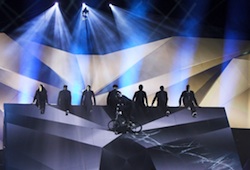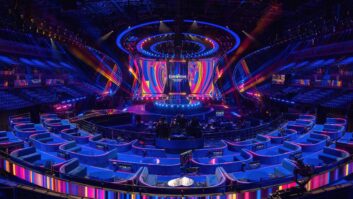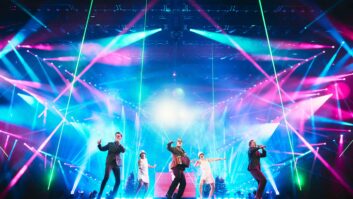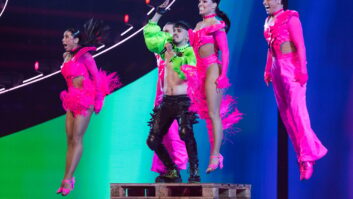
Cast Group’s 6D live tracking solution, BlackTrax, made its big show debut at the 2013 Eurovision Song Contest in Malmö, Sweden, this month. BlackTrax performed “flawlessly” in the first high-profile demonstration of its creative and practical potential for the realtime automation of lighting and video content.
Working in conjunction with Martin Kuhn of Switzerland’s Moodbox, CAST deployed BlackTrax for two major performances at the event – the opening act of the semi final, ‘Urban Orchestra’, and the return to the Eurovision stage of 2012’s winner, Loreen. Technical Director, Ola Melzig commented: “Thanks to BlackTrax, we were able to do things that no one has ever done before – it took the show to a new level. With over 1200 lighting fixtures and almost 30 of the largest, brightest video projectors in the world, we clearly don’t make equipment decisions casually. Given the size and complexity of Eurovision you can’t have any mistakes. The precise target information that BlackTrax provided was perfect for the acts it was used on.”
During the performance by Urban Orchestra, BlackTrax was used to track BMX riders and rollerbladers onstage, enabling effects to be projected on the floor at their exact position, without any lag or drift of the effect from the performer. Dancers, meanwhile, performed in line with pre-programmed effects and therefore were required to be in exactly the right position at the right time in order for effects to follow them accurately. At times this proved tricky to pull off, but thanks to BlackTrax, the skaters and riders (with the infrared emitter LEDs of the BTBeacon attached to their helmets) had the freedom to time their stunts as they wished and land wherever they wanted or needed to, without having to worry about cues and positioning.
The video programmer/operator initially included the pre-programmed (non-BlackTrax) content, which comprised brightly coloured trails that the BMX riders and inline skaters were supposed to follow. At times when they were too early or in the wrong position, the trails were out of sequence with the performer, at one point lagging behind by about a second, while the trails positioned by BlackTrax were, of course, always on-target and on time. Subsequently, the video programmer chose to remove the pre-programmed paths, leaving only the BlackTrax trails.
BlackTrax was then used during the final of the contest for Loreen who, along with several other aerialist performers, was tracked while ‘flying’ above the stage. The light tracking sequence for Loreen was designed by Emma Landare (LD for interval acts), who dedicated three lights to each of four flying pairs; 12 lights in total. To do this without BlackTrax would have required either 12 follow spot operators (four of which would need to be positioned on the floor behind the stage) or pre-cueing of moving lights, however, in this case, the unpredictable swaying of the aerialists could not have been compensated for. BlackTrax delivered the best of both worlds – tracked lights that followed each and every random movement, without the inconvenience of using and positioning a large number of follow spots. Lighting Designer, Fredrik Jönsson, said: “BlackTrax provided us with this very cool effect with Loreen where we tracked flying dancers in realtime with floor lights. The only way of doing this without BlackTrax would have been with extra followspots, which we could not have in that position since they would have been seen by the cameras.”
Interestingly, CAST was informed by the harness and flying rig operators that some of the aerialists had tried to ‘beat’ the BlackTrax system by getting out of the light during the pre-rehearsal testing and, with absolutely no success, thought this was great fun.
With regards to the BT Beacon, one of the performers commented, “I was concerned that the beacon would get in the way of the harness or cause discomfort, but they were very small and none of us even noticed them – they certainly didn’t impede our performance.”
Individual acts aside, the overall performance of BlackTrax in the demanding environment of the Eurovision arena was deemed to have been exceptional. The BlackTrax cameras (BTSensors) were spaced about 215 feet apart from each other and, despite the fact they weren’t placed to cover the entire venue, were nonetheless able to track BTBeacons as distant as the tunnels through which the audience members enter. Furthermore, despite more than 70 Wi-Fi devices in the venue used to run wireless DMX control, multiple high-power wireless video camera signals, wireless headsets and in-ear microphones resulting in an enormous level of RF noise, none of this interfered with BlackTrax.
“As the first big test of BlackTrax on this kind of scale, it was very promising,” commented Martin Kuhn, “however this is just the very beginning of what the overall BlackTrax solution can do. The tasks it was given were performed flawlessly, but the way they used it this time did not even scratch the surface of what it can really do. Eurovision opened the BlackTrax box of tricks. They have given us a taste of what is possible. It was a fantastic start and showed the direction in which things can go, but it has so much more potential yet to reveal. In the future it could really change the way shows like Eurovision work, especially in regard to issues such as the number of follow spots lighting designers are able to specify. With BlackTrax the number is not an issue – if you have one position, you have every position.”
www.blacktrax.ca




